The Brazos Performance Preview: AMD E-350 Benchmarked
by Anand Lal Shimpi on November 16, 2010 12:01 AM ESTMobile IGP Comparison
I narrowed down the platforms for our mobile IGP comparison. I simulated a Core i3 350M by taking an i3-530, underclocking it (I couldn't do anything about the 4MB vs. 3MB L3 cache) and capping its GPU frequency at 667MHz. This is the best case scenario for the i3-350M, and as you'll see below, it doesn't really matter. I also paired a 2.2GHz Pentium Dual-Core with a G45 motherboard, agian simulating the cheaper mobile Pentium platform. Finally I installed Windows 7 on the 1.6GHz Core 2 Duo based 11-inch MacBook Air with its GeForce 320M to give you an idea of the upper bound for mobile performance with what might as well be a low end discrete GPU.
Updated: I've added performance results from a simulated Core i3-330UM, the E-350's competition in ultra portables.
We'll start with Modern Warfare 2:
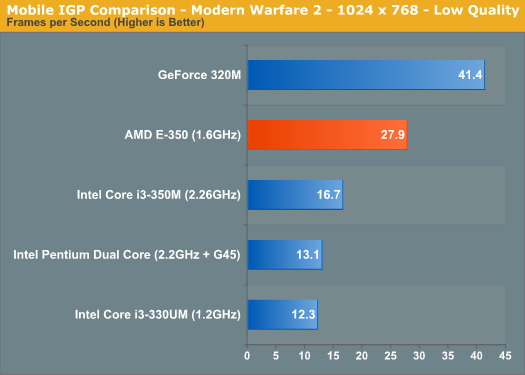
The E-350 puts the i3-350M, i3-330UM and Pentium DC to shame, delivering 67% better performance. The frame rate is just shy of being totally smooth however. I found that in most modern games 1024 x 768 would result in frame rates just under 30 fps.
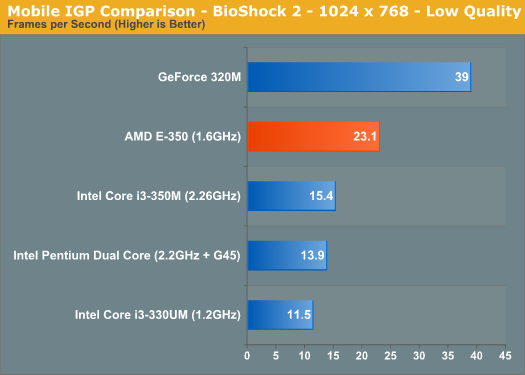
BioShock 2 showed a similar performance advantage. Again we're not able to break 30 fps but the performance advantage is huge compared to the Intel platforms with integrated graphics.
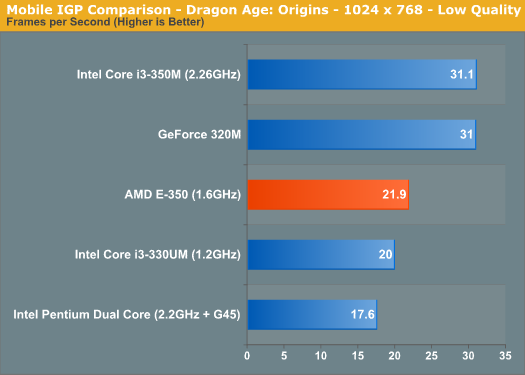
Dragon Age: Origins is mostly CPU bound at low quality settings and thus there's no real advantage to the E-350's Radeon HD 6310 GPU. It's faster than the Pentium/G45 platform, but significantly slower than the i3-350M. I expect most games however to be GPU bound at these settings across the board.
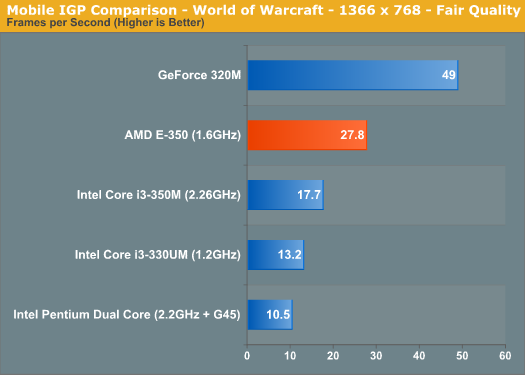
World of Warcraft continued the trend. The E-350 ended up 57% faster than the i3-350M, although still fell short of a discrete GPU.
Of course I wondered how well Brazos would play Starcraft 2:
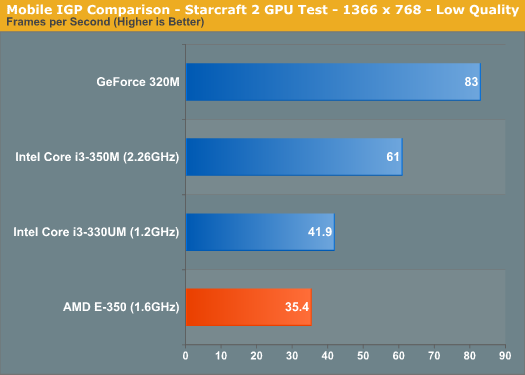
The GPU handles SC2 just fine, however the game is very CPU dependent and thus you see a pretty big advantage from the mainstream i3 system. The comparison is a lot closer when we look at the i3-330UM. The E-350 won't be able to play SC2 as well as a $500 mainstream notebook, but it'll be comparable to an ultraportable running ULV Arrandale.
We don't have numbers for the G45 platform here because the system wouldn't run our benchmark (our tests use an older version of SC2 which apparently had issues with the G45 drivers).
Our SC2 CPU test gives you an idea of the lower end of performance in large multiplayer battles:

The E-350 offers only 58% of the performance of the i3-350M system. The Bobcat cores do hold the platform back from time to time. Again, compared to the i3-330UM there's no performance difference at all.
Just for kicks I also ran the Civilization V benchmark, which gave us two datapoints: GPU performance and no-render/CPU performance.
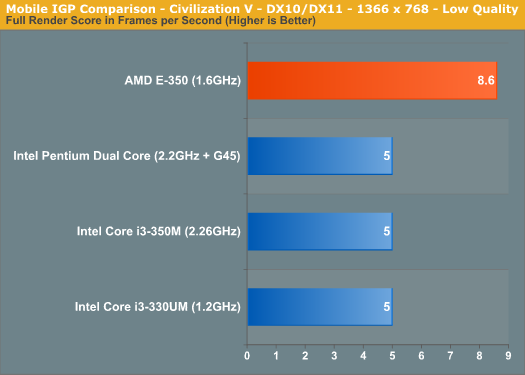
The benchmark doesn't score well on either platform, although AMD does hold a 72% performance advantage over the i3 and G45 platforms. The CPU test puts the E-350 at about 55% of the speed of the Pentium dual core platform.
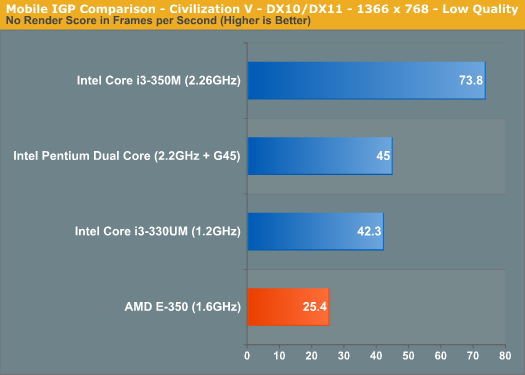
Civ V is one area where the Arrandale CPU advantage wins out over GPU performance.
Overall, the E-350 has no problems outperforming any of the current Intel integrated graphics offerings in 3D games. In CPU bound titles the E-350 loses out to the mainstream i3, but is competitive with ultra low voltage i3s. Just as with Atom, you'll have to sacrifice performance vs. a mainstream notebook, but compared to low voltage Arrandale the E-350 can hold its own.










207 Comments
View All Comments
Dark_Archonis - Tuesday, November 16, 2010 - link
All of us know some Anandtech posters are AMD PR people, so no surprise here.silverblue - Wednesday, November 17, 2010 - link
Yep, and I, for example, wouldn't be running a low-end Phenom II X3 setup if I was getting fees from AMD for hyping their products (which I clearly am not, anyway).Do yourself a favour and stop spouting rubbish about conspiracies where none exist.
nitrousoxide - Tuesday, November 16, 2010 - link
OK, so Anand said that no worries about CULV Sandy Bridge series because they are more expensive, power-hungrier and bigger chips which is not a good deal for OEM manufacturers. What about the new Atom CPUs then? Intel is going to upgrade them to 32nm, which is twice as faster as today's 45nm Atoms, or half the power consumption at the same performance. Though bobcat has more efficient OoO architecture, Intel can easily improve the performance of Atom by adding more cores or tune up the frequency given the superiority of 32nm.AMD will definitely win this wave of competition, but its successor won't come until 2012. How will Fusion APUs compete with the future Atoms which will be defnitely faster then current models?
silverblue - Tuesday, November 16, 2010 - link
Yes but isn't Brazos 32nm at the very least? There's really no sense in throwing out a 3GHz dual core APU of this class because it would simply use too much power. Also, there's not much justification for any sort of Turbo clocking.What MIGHT significantly improve performance would be a dual channel memory controller (especially in the case of the GPU) but I don't know what that would mean for the die size nor the power consumption.
Let's remind ourselves of a couple of things - AMD's two thread out-of-order architecture is still beating Intel's four thread in-order architecture at the same clock speed. Brazos also has Atom completely beaten in lesser threaded workloads. Considering the primary target of these platforms isn't supposed to be massive workloads, the AMD solution will still be more capable than Intel's... for now.
silverblue - Tuesday, November 16, 2010 - link
Apparently Brazos is 40nm. When they put it onto 32nm, I imagine that anything Intel does with Atom in terms of a die shrink won't be enough to put it back in front of Brazos. We'll see.mino - Tuesday, November 16, 2010 - link
No 32nm SOI Bobcat APU will see the light of the day.There will be a Zacate/Ontario successor in H1 2012 at 28nm bulk(GloFo).
2-4 Bobcat+ cores, ~120 SP's (mostly likely 2*64 SP's of a newer design)
silverblue - Wednesday, November 17, 2010 - link
So that's where 28nm came in. You must forgive me, I lost track on that one.So yes, imagine the power drop from 40 to 28 even with a more powerful CPU. This one might even please Dark_Archonis. Might.
mino - Wednesday, November 17, 2010 - link
More like making him furious :Dmino - Tuesday, November 16, 2010 - link
"Worried about whether it can survive the next wave of attack by Intel"The funny part is that AMD's 2011 product portfolio is as strong as it has not been for the past 15yrs.
It is AMD attacking this time around gals. Just think about it for a minute ... 1999 ... 2003 ... 2011 ...
Lolimaster - Tuesday, November 16, 2010 - link
Q4 2011/Q1 2012 TSMC will deliver the next low power Fusion at 28nm.Krishna & Wichita with 2 and 4 cores flavors (real ones).
Anandtech an Inteltech site? We all know that, just leave with it.